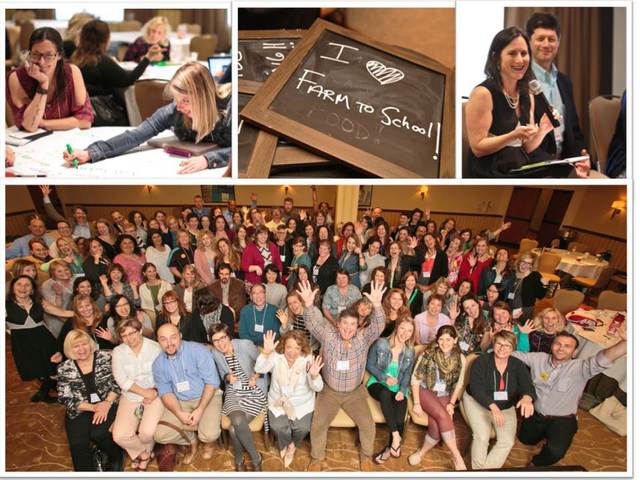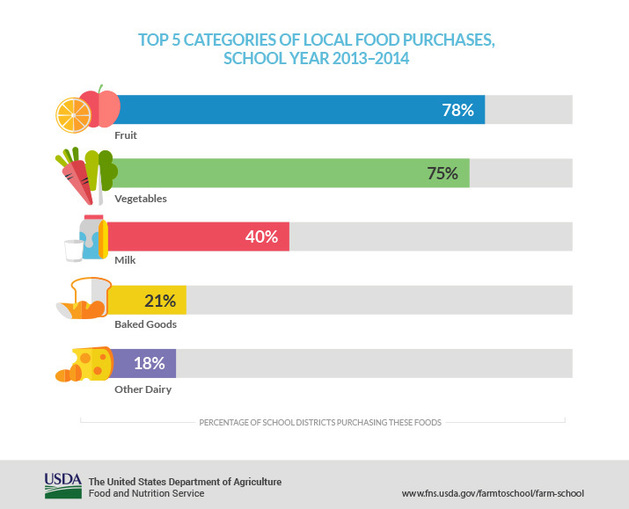Setting yourself up for success
Spring into next school year with a plan in place for your farm
to school efforts. Whether you’re starting a new
garden, issuing solicitations or gearing up for a summer program, our Planning for Farm
to School Success webinar series has something for everyone. This 11-part
series guides you through the USDA
Farm to School Planning Toolkit. Recordings of the first eight webinars are
now available and cover topics such as food safety, procurement and menu
planning. These 30 minute webinars feature guest speakers and highlight best
practices from across the country.
Don’t miss the last three webinars in the
series!
Program
Sustainability: April 28, 2:00 PM EDT
Your farm to school project is blooming! But what will happen if funding levels
decrease or community interest lags? With this webinar, plan ahead for these
potential scenarios and learn about program sustainability best practices.

Evaluating
Your Program: May 12, 2:00 PM EDT
We all know that farm to school programs create positive economic impacts for
local and regional farmers and improve the health and well-being of our
nation’s children. But how can we measure these changes to document these
positive impacts? Hear from seasoned farm to school evaluators to learn best
practices for evaluating your farm to school efforts.

Tying
it All Together and Digging In:
May 26, 2:00 PM EDT
Join us for a healthy dose of motivation! Deborah Kane, Director of USDA’s
Office of Community Food Systems, will hit the highlights by showing how local
procurement fits into the larger farm to school picture and share several
resources to help you meet your local purchasing goals.

Grantee Spotlight
On April 13-14, just over 100 USDA farm to school grantees
representing 56 projects from across the country gathered in Fort Worth, Texas
for the annual USDA Farm to School Grantee Gathering. Through peer learning
workshops, networking activities and one-on-one consultations, USDA farm to
school grantees heard from peers, program staff and national experts on best
practices related to farm to school planning, implementation and grant project
management. Thank you to all the grantees for attending. Your passion and
effort to bring the farm to school is what makes this program a success!


For
many school districts, buying local foods starts with fresh fruits and
vegetables. For example, 78% of school districts engaged in farm to school
activities served local fruit and 75% served local vegetables. Fresh fruits are
especially easy because many can be served with little to no preparation beyond
washing; however, the most comprehensive local food purchasing programs
incorporate many different types of local products such as local milk, baked
goods and other dairy products. These are other top products purchased
locally by school districts. As more and more schools use local foods in school
meals, look for future growth in the following product categories including
local plant-based proteins, herbs, meat or poultry, eggs and grains and flour

Community Food Systems
in Native Communities Webinar Series
Incorporating
Traditional Foods in Child Nutrition Program Menus: April 20, 3:00 PM EDT
Where do traditional foods
fit?! In this webinar, we'll discuss best practices for incorporating
traditional foods into child nutrition programs. Alaska's Department of Natural
Resources will share how Alaskan communities are integrating local foods and
Jenny Montague, a nutritionist with FNS, will share some real life examples of
districts that are substituting local foods into CNP meals.

Engaging
Students: May 4, 3:00 PM EDT
Incorporating
nutrition education related to traditional food items into cultural activities
such as ceremonial songs and storytelling helps students to identify food as
part of Native American heritage. This webinar will help you plan for farm to
school educational efforts that engage students throughout the year. Gloria
Begay, a Navajo Educator, will highlight school garden efforts and local foods
activities in summer meals.

Partnering
for Success in Tribal Communities: May
20, 3:00 PM EDT
Everything
is better together, right?! In the final webinar in a series of four, we’ll
hear from two practitioners who illustrate that partnerships make the
difference in keeping food traditions alive in child nutrition programs. This
webinar will identify strategies to engage local producers and community
leaders in your farm to school efforts.

Summer Meals
Connecting
Summer Meals Sponsors with Wholesome, Free Food: April 27, 2016, 2:00 PM EDT
Summer meals sponsors and sites that
want to improve meal quality by incorporating fresh, nutritious, and/or local
ingredients into their meals can take advantage of a new online tool that
connects them with wholesome, excess free food.
The online tool is called MEANS (Matching
Excess and Need) and it notifies eligible non-profits (aka summer meals
sponsors) of free food in their area. Join this webinar to learn more about
MEANS and how you can use this revolutionary tool to improve your meals and
help reduce wasted food. As a summer meals sponsor or site, you can also
use MEANS to notify other organizations when you have excess food to
donate.

Donating and
Receiving Wholesome, Excess Food in School Meals Programs: May 4, 2:00 PM EDT
USDA encourages donations of
wholesome, excess food through the school meals programs, but rules regarding
school food donations are regulated by local health departments and school
districts. Join this webinar to hear from schools that not only have
successfully implemented food donation programs in their cafeterias to reduce
wasted food and feed hungry families, but have used the program to educate
their students about the impacts of wasted food.
The webinar will also feature examples
of schools receiving donations of fresh produce from local grocery stores to
use in afterschool feeding programs. Food donation in schools can be a
two-way street!

|
USDA’s Food, Nutrition and Consumer Services just released 50 new, mouth-watering recipes for schools chefs on our What’s Cooking? USDA Mixing Bowl
website. Some are existing USDA recipes that we’ve updated, while
others are brand new recipes that students will love. These tasty,
kid-approved recipes are tailored for large quantity food service
operations in 25, 50, or 100 portions. And each recipe includes a
nutritional breakdown as well as crediting information on how the recipe
contributes toward updated meal pattern requirements for the National School Lunch Program and other USDA child nutrition programs.
|
|
 |

|